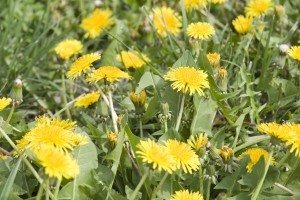 Oftentimes during the heat of the summer or drought, you’ll notice weeds prospering while the rest of your landscape suffers. That’s because many weeds have adapted not just to survive, but to thrive in extreme conditions. Indiana has an abundance of both native and non-native weeds, which creates a challenge to keeping your lawn, garden, and landscape weed free.
Oftentimes during the heat of the summer or drought, you’ll notice weeds prospering while the rest of your landscape suffers. That’s because many weeds have adapted not just to survive, but to thrive in extreme conditions. Indiana has an abundance of both native and non-native weeds, which creates a challenge to keeping your lawn, garden, and landscape weed free.
What is a weed? A weed is any invasive plant that is growing where you don’t want it to grow. Weeds have been lumped into three main categories:
- Broadleaf (dandelion, white clover, chickweed)
- Grassy (crabgrass, bermudagrass, foxtails)
- Non-Grass (wild garlic, yellow nutsedge)
Weed seeds exist in most landscapes and spread in a variety of ways—wind, animals, infested soil or compost additions, low-quality grass seed, various landscape equipment, and many other ways. In dealing with weeds, you need to take care of your landscape correctly to avoid their development. Things like incorrect watering, improper fertilization, compacted turf, insect damage or disease, poor drainage, or even the height of your grass can cause problems. It is best to address weed problems as soon as they occur, ideally before germination, in an effort to prevent the seed from spreading.
The safest, easiest, and most environmentally friendly way to address a weed problem is to remove them by hand or with garden tools. Weeds can be removed at any time, but following a good rain tends to be the best time as the soft soil makes them easy to pluck from the ground. Pull the weed close to the base, lifting out as much root as possible.
For larger weeds with extensive root systems, like thistles and dandelions, use a garden fork, spike, or trowel. Keep the hole as small as possible, placing the tool close to the weed’s base and driving it deep into the ground. Loosen the surrounding soil. Grab the weed under its crown and pull out the entire root.
While weed removal by hand is the easiest method, it may not be the most practical solution for large turf areas and gardens overgrown with weeds. In this case, we would suggest using an herbicide. When applied properly, herbicides are very effective at eliminating weeds.
Herbicides are available in two main categories—systemic or contact. Systemic herbicides penetrate the weed through the root system or leaves, killing it from the inside. Contact herbicides attack the outside of the weed reducing its ability to grow through photosynthesis.
Within these two main categories, herbicides may also be selective or non-selective. Selective herbicides kill only certain plants. A good example of a selective herbicide is a broadleaf lawn application that is designed specifically for the removal of broadleaf weeds. These products will remove the weeds without killing the established lawn in which the weeds grow. Non-selective herbicides will kill all plants they come into contact with, so it must be used with discretion. This type of product is typically used when preparing a new area for planting.
Finally, there are pre-emergent and post-emergent herbicides. Pre-emergent herbicides are designed to be applied before weeds germinate, thus making them effective at preventing weed problems. When used properly, pre-emergent herbicides will prevent weeds from growing while protecting desired plants. Pre-emergent does require proper timing for it to be effective—typically very early in the season. On the other hand, post-emergent herbicides are designed to attack weeds that are already established, and therefore should be applied later in the growing season, but before they’ve gone to seed.
The following schedule can be used as a general guide in scouting for weeds as well as determining proper timeframes to make herbicide applications:
Early spring: Inspect your lawn as spring approaches and select proper treatment based on findings. If using herbicide, apply a pre-emergent shortly before annual weeds, like crabgrass, begin to grow in the spring. Consider using a pre-emergent combined with fertilizer as an early lawn treatment.
Late spring: In the middle of the growing season, determine which weeds have come back and repeat weed killer application or remove weeds selectively with herbicide or by hand.
Fall: If using herbicide, treat your lawn one last time with a general weed killer after the final mowing. Remove large weeds by hand to ensure they will not survive over the winter.
It’s important to note that the timing of pre- and post-emergent herbicide applications is critical. Applying them too early or too late will do very little. Pre-emergents can also harm some desirable ornamental plants and turf grasses. As always, read all packaging, labels, instructions, safety warnings and other pertinent information from the manufacturer. If not used properly, herbicides can cause damage to your landscape or even yourself.
If you have any questions regarding your property and would like to speak to a professional, give us a call at 317-575-1100 or simply fill out the form below. And don’t forget to download a copy of our FREE Guide to Common Weeds in Indiana.
Please select a valid form
